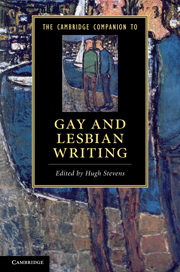Book contents
- Frontmatter
- Homosexuality and literature: an introduction
- Part I Repression and Legitimation
- 1 Homosexual writing on trial: from Fanny Hill to Gay News
- 2 Psychoanalysis, homosexuality and modernism
- 3 Lesbian modernism: writing in and beyond the closet
- 4 The erotics of transgression
- 5 Normality and queerness in gay fiction
- Part II Affiliations
- Part III Literary Traditions
- Guide to further reading
- Index
2 - Psychoanalysis, homosexuality and modernism
from Part I - Repression and Legitimation
Published online by Cambridge University Press: 28 January 2011
- Frontmatter
- Homosexuality and literature: an introduction
- Part I Repression and Legitimation
- 1 Homosexual writing on trial: from Fanny Hill to Gay News
- 2 Psychoanalysis, homosexuality and modernism
- 3 Lesbian modernism: writing in and beyond the closet
- 4 The erotics of transgression
- 5 Normality and queerness in gay fiction
- Part II Affiliations
- Part III Literary Traditions
- Guide to further reading
- Index
Summary
“Was I ill? Have I recovered? Has my doctor been discovered?” Nietzsche / Psychoanalysis has often been seen as complicit in dominant social constructions and constrictions of homosexuality, and there is certainly some evidence for this in the classic psychoanalytic texts, from the early works of Freud onwards. Certain parts of the psychoanalytic institution in some historical periods have been particularly wedded to such social orthodoxies, the post-war American school for instance; and even today, theories and practices of psychoanalysis at large are not entirely free of homophobic positions. As a whole, across its historical and geographical range, psychoanalysis has achieved rather ambivalent forms of recognition for gay and lesbian sexualities. As in its work on gender, in the field of sexuality orthodox psychoanalysis at once affords certain forms of emancipation for alternative models and retains an attachment to the conventions of the patriarchal culture that such models would challenge. From the outset, psychoanalysis dared to speak the name of homosexuality, at a time when it was, often violently, unspeakable. Yet the psychoanalytic modelling of gay sexuality, derived from that which it constructs for gender, imposes discursive constraints of its own. Freudian psychoanalysis makes homosexuality speak its name in ways that are coloured by the suppositions of its broader project and constrained by those of the culture out of which it emerges.
- Type
- Chapter
- Information
- The Cambridge Companion to Gay and Lesbian Writing , pp. 34 - 49Publisher: Cambridge University PressPrint publication year: 2010
- 2
- Cited by

